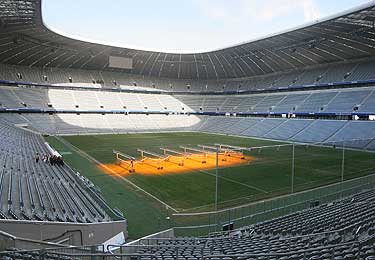|
|
|
Allianz ArenaThe New Stadium of Bayern Munich  Bayern will take possession of their spectacular new home ground in time for the 2005-6 season. The venerable Olympic stadium and its uniquely elegant glazed roof came to symbolise the city of Munich around the world, but one can only guess at the likely impact of the breathtaking Allianz Arena as the new landmark symbol of the city and especially Bayern Munich. The 66,000 capacity Allianz Arena, set to host the Opening Match of the 2006 World Cup, is reckoned to be Europe's most modern stadium. The exterior provides its most extraordinary feature: at Bayern home games, a cascade of red will be projected onto the smooth translucent shell, transforming the structure into a luminous beacon visible for miles around. Once inside, facilities for fans and business guests encompass the widest imaginable range, with a vast choice of catering, entertainment and leisure areas, Halls of Fame, crèche and kindergarten services, fan megastores, offices and conference rooms to name but a few. No less than 6,500 square metres will be given over to restaurant, snack and bar areas. The die-hard fans will be stunned at how close they are to the pitch. Unlike the Olympic stadium, there is no running track and no curve at the ends of the ground, a feature warmly welcomed by Felix Magath on his first visit to the site. "I really don't know if there's another stadium where the spectators are as close as here at the Allianz Arena. After taking it all in, I'm already looking forward to the season after next," the 51 year-old remarked. Bayern general manager Uli Hoeneß shared the coach's enthusiasm and agreed he could hardly wait until completion on 30 April 2005. "We'll see history written at this stadium," the senior official declared, "my hope is we'll play dream football next year at this dream stadium."
| ||||||||